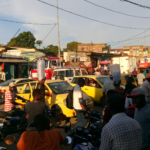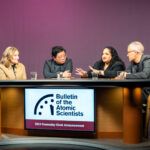Doomsday Clock Symposium to be held November 29th in Washington, DC
By Bulletin Staff | September 18, 2012
The focus of the 4th Doomsday Clock Symposium is: managing risks of dangerous technologies. Our purpose is to explore the idea of risk, its meanings, and how individuals, the public, and policy leaders think about the risk of catastrophe from low probability events such as nuclear war, terrorist attacks, the release of lethal pathogens, and the weather-related consequences of climate change.
Bulletin of the Atomic Scientists
Doomsday Clock Symposium
November 29, 2012
American Association for the Advancement of Science
Washington, D.C.
Managing risks of dangerous technologies
The focus of the 4th Doomsday Clock Symposium is: managing risks of dangerous technologies. Our purpose is to explore the idea of risk, its meanings, and how individuals, the public, and policy leaders think about the risk of catastrophe from low probability events such as nuclear war, terrorist attacks, the release of lethal pathogens, and the weather-related consequences of climate change. We will hear presentations about whether and how such risks can be managed, and what all this means for public policy about nuclear security, biosecurity, and climate change.
In 1961 President John F. Kennedy likened the risk of catastrophe from a nuclear exchange between the United States and the Soviet Union to a "nuclear sword of Damocles" hanging by the slenderest of threads over every man, woman, and child on the planet, which, at any moment, could be cut by accident or miscalculation or madness.
Since those terrible days of the Cold War, successive measures to prevent nuclear war and to reduce the risk of catastrophe have taken the form of bilateral arms reduction treaties, communications hotlines between the superpowers, and a global treaty to prevent the proliferation of nuclear weapons. But even with these steps and the reduction in tensions between the United States and Russia, some measure of risk still is linked to the spread of nuclear bomb making material and the technology that enriches uranium for civilian power. With the terrorist attacks of the 1990s and 2000s, the public has become even more aware of the possibility of an attack with a nuclear weapon or device.
After the nuclear disaster at Fukushima Daiichi in Japan, public discussion focused on the health risks to individuals from exposure to low doses of radioactive material spewed into the atmosphere from the explosions at the power plants. Confusion about how to think about risk fed into fear about radioactive substances that cannot be sensed directly and contributed to unease about the safety of nuclear power plants.
So how do we think about risk? How do individuals understand the probabilities of future events and calculate the consequences for their safety and security? And most important for addressing threats to humanity, how do the costs of avoiding or mitigating those risks stack up against the benefits? In the face of global threats from technologies that also have brought great benefits, like fossil fuel-burning engines, recombinant DNA, and nuclear energy, how might public policies be devised based on the most current understanding of risk? How might the public learn about the trade-offs between costs and benefits in light of the results of risk analyses? And how can authorities communicate about risk in ways that dispel confusion and instill confidence?
9:00 Welcome
Alan Leshner, President and CEO, AAAS
Robert Socolow*, Chair
9:15 Introduction to Symposium
Lynn Eden*, Program Chair
9:30 Opening Keynote Address: What is risk?
Paul Slovic, University of Oregon
Discussion: Rod Ewing*, University of Michigan
10:45 Panel 1: Managing the risks of nuclear fuel cycles
Moderator: Thomas Rosenbaum*, University of Chicago
Steve Fetter, University of Maryland
Gordon Adams, American University
John Polanyi**, University of Toronto
Baruch Fischhoff, Carnegie Mellon University
12:30 Luncheon
Leonard Rieser Fellow: Shahrzad Mohtadi
1:30 Panel 2: Risks from emerging technologies in the life sciences
Moderator: Kennette Benedict, Bulletin of the Atomic Scientists
Ron Atlas, University of Louisville
Sonia Ben Ouagrham-Gormley, George Mason University
Paul Slovic, University of Oregon
3:00 Panel 3: Estimating the probability of future changes to the climate
Moderator: Rob Socolow*, Princeton University
Richard Somerville*, University of California, San Diego
Elizabeth Wilson*, University of Minnesota
Sivan Kartha*, Stockholm Environmental Institute
4:30 Conclusion: Forecasting and public policy
Moderator: Jennifer Sims*, Chicago Council on Global Affairs
Dan Kammen, UC Berkeley (via video)
Jason Matheny, IARPA
5:30 Reception
Featured remarks: Joe Cirincione, Ploughshares Fund
Introduced by: Bill Revelle***, Chair
6:30 Dinner at Acadiana Restaurant
Keynote address: Gary Samore, Special Assistant to the President and White House Coordinator for Arms Control and Weapons of Mass Destruction, Proliferation, and Terrorism
Introduced by: Lawrence Krauss**, Arizona State University Co-Chair
Registration is now open.
The Doomsday Clock Symposium is an Invitation Only event held annually by the boards of the Bulletin of the Atomic Scientists. For an invitation, contact Lisa McCabe.
* Bulletin of the Atomic Scientists, Science and Security Board
** Bulletin of the Atomic Scientists, Board of Sponsors
*** Bulletin of the Atomic Scientists, Governing Board
Together, we make the world safer.
The Bulletin elevates expert voices above the noise. But as an independent nonprofit organization, our operations depend on the support of readers like you. Help us continue to deliver quality journalism that holds leaders accountable. Your support of our work at any level is important. In return, we promise our coverage will be understandable, influential, vigilant, solution-oriented, and fair-minded. Together we can make a difference.














